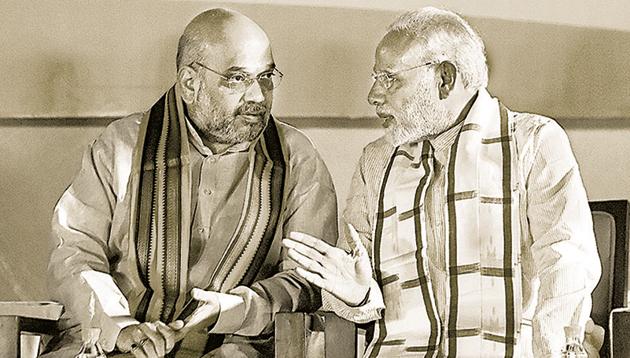It is back to the Hindutva card in Uttar Pradesh
To counter the BSP-SP alliance, the BJP is also trying to project icons, heroes, kings and warriors of the Dalit and OBC-MBC communities, by erecting statues and organising celebrations commemorating them
Uttar Pradesh has always been an important political space. Victory in the state is the route to power in Delhi for any political party. The Bharatiya Janata Party (BJP) which swept the state in 2014, and also in the 2017 state elections doesn’t seem as comfortable as it should be ahead of the 2019 Lok Sabha elections. The Samajwadi Party-Bahujan Samaj Party (SP-BSP) alliance is a threat to the BJP. The BJP’s defeat in the Phoolpur and Gorakhpur Parliamentary seats has shaken the party’s confidence. The defeat in Kairana has compounded this.

This challenge has often figured in the chintan baithaks (brainstorming sessions) of the Rashtriya Swayamsevak Sangh-BJP (RSS-BJP). Even as BJP leaders downplay the threat, the party’s political strategies paint a different picture. Many indicate the BJP’s continuous efforts to minimise the impact of a potential SP-BSP alliance in the state. The formation has already dented the BJP’s air of invincibility. Now, the conversation in tea shops and village chaupals is about the formidable challenge posed by this alliance.
According to media reports, Prime Minister Narendra Modi is to launch his 2019 election campaign from Varanasi. The question is : What are the strategies on which the BJP is working to counter a SP-BSP alliance?
For starters, the BJP is trying to create a strong Hindu identity which may help form a social alliance that goes beyond caste in Uttar Pradesh. This is visible in its efforts to play up Hindu fairs, festivals and icons, turning these into political opportunities . Both the Ayodhya-Deep-Diwali and the Prayag Kumbh are examples of this. The BJP and the RSS are also working to ratchet up the Ram Janmabhoomi issue. Changing the names of cities such as Allahabad and Mughal Sarai are part of the politics of reframing Hindutva through the revival of a glorious past. Chief Minister Yogi Adityanath is regularly shown on television participating in religious ceremonies . The BJP and the Sangh Parivar see this as a way to counter Mandal politics and develop a broad alliance of castes under the Hindutva umbrella.
This social engineering is called Samagra Hidutva; under this, the BJP wants to integrate other backward castes (OBCs) and Dalits into the Hindutva fold. The BJP and the the RSS are holding frequent interactions with Dalits and OBCs. This is important because the SP- BSP alliance is working to form an alliance of Muslims and Yadav-Jatav-Nishads.
The BJP is also trying to project icons, heroes, kings and warriors of the Dalit and OBC-MBC communities, by erecting statues and organising celebrations commemorating them. For instance, Hindu king Suhel Dev is being invoked as the Rashtra Rakshak Hindu Samrat (a Hindu emperor who saved the nation) by the BJP. Dev is a caste icon for the Dalits and marginalised castes such as Bhars, Tharus and Pasees.
The BJP is also working on creating a non Yadav-Non-Jatav OBC -Dalit alliance, the likes of which helped it emerge triumphant in the 2014 parliamentary elections and the 2017 Uttar Pradesh assembly elections. It is working to solidify the Patel-Maurya-Kurmi alliance among the OBCs and a Pasee-Kori -Sonkar social coalition among the Dalits. BJP state leaders and its president Amit Shah regularly visit caste conferences organised by the communities themselves and sometimes even sponsor them.
Specifically, the BJP is trying to develop the OBC-Dalit base in two ways. The first, by forming alliances with caste-based parties such as the Apana Dal and the Suhel Dev Bharatiya Samaj Party; and the second, by providing representation to these communities in the party and the government. Deputy chief minister Keshav Maurya and Swatantra Deo Singh, a powerful Kurmi leader, have emerged important figures in the state’s politics. people familiar with the matter say Swatantra Deo Singh is likely to get presidentship the of Uttar Pradesh Bharatiya Janata Party. Among Dalits, an important community, the Koris feel proud that Ramnath Kovind, from their community, has become the President. Due to the BJP’s efforts , Pasees are also getting importance in the party and the governance structure. Besides this, the RSS is working hard to mobilise smaller Dalit castes and MBCs- OBCs through projects such as opening schools, launching micro-finance programmes and cleanliness campaigns in areas dominated by them.
The only thing which is not yet clear is what programme-based strategy the BJP is planning in the coming year to counter the growing anti-incumbency which may benefit the SP-BSP alliance.
Then there is the BJP’s X-factor -- the Modi magic, although the extent to which this will work in the run-up to the 2019 elections remains to be seen.
Badri Narayan is a professor at Govind Ballabh Pant Social Science Institute, Allahabad
The views expressed are personal



